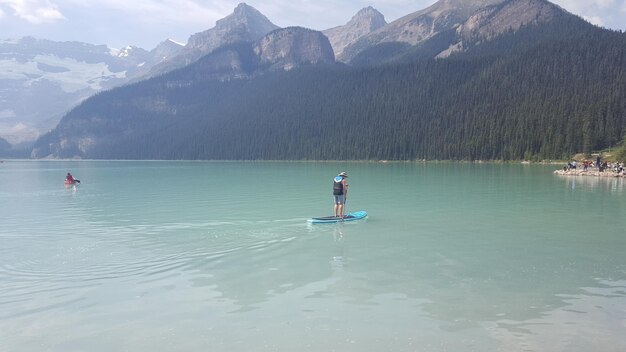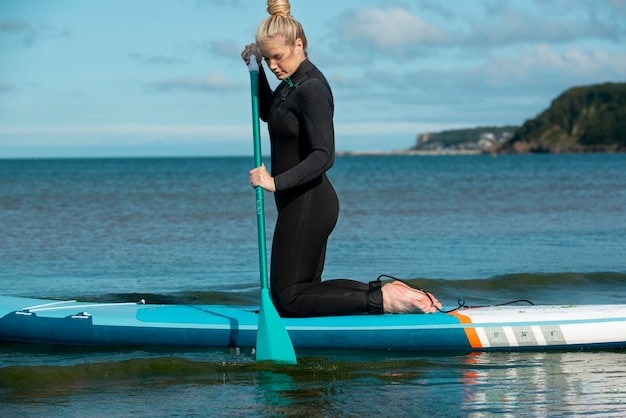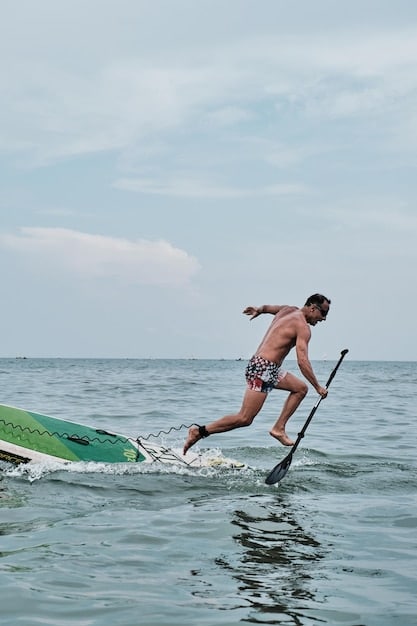Is Stand-Up Paddleboarding Right for You? 2025 Stability & Performance Guide

Stand-up paddleboarding (SUP) offers a unique blend of stability and performance, making it appealing to diverse skill levels; this 2025 analysis weighs factors like board design, water conditions, and individual fitness to help you determine if SUP is your ideal watersport.
Considering hitting the water with a paddle in hand? Is Stand-Up Paddleboarding Right for You? A 2025 Analysis of Stability vs. Performance will help you discover if this popular watersport matches your fitness level and adventure desires.
Understanding the Allure of Stand-Up Paddleboarding
Stand-up paddleboarding, or SUP, has surged in popularity, attracting enthusiasts of all ages and fitness levels. This widespread appeal stems from its accessibility and versatility, offering a blend of exercise, relaxation, and exploration.
Why is SUP So Popular?
SUP provides a full-body workout while being gentle on the joints. It’s a fantastic way to enjoy the outdoors, whether you’re gliding across a serene lake or navigating ocean waves.
The Versatility of SUP Activities
From leisurely paddles and yoga sessions to fitness training and even fishing, SUP adapts to various interests. This adaptability makes it a sport that can grow with you, offering new challenges and experiences as you progress.
- Fitness Benefits: Engages core muscles, improves balance, and provides a cardio workout.
- Mental Wellness: Offers stress relief and a connection with nature.
- Accessibility: Suitable for a wide range of ages and fitness levels.
- Exploration: Allows access to unique waterways and perspectives.
The draw of stand-up paddleboarding lies in its simplicity and adaptability. It’s a sport that allows for personal expression and connection with the water, creating a unique and rewarding experience.
Assessing Stability: Factors for Beginners
Stability is paramount, especially for beginners venturing into stand-up paddleboarding. Several factors influence a board’s stability, impacting the ease and enjoyment of your initial experiences.
Board Width and Thickness
Wider and thicker boards offer greater stability, making them ideal for novices. These boards provide a more forgiving platform, reducing the likelihood of wobbling or falling.
Board Length and Volume
Longer boards generally track straighter, while higher volume boards offer increased buoyancy and stability. A combination of length and volume can contribute to a comfortable and balanced ride.

Ideal Board Types for Beginners
Look for all-around SUPs designed with stability in mind. These boards typically feature a wider base, generous volume, and durable construction, ensuring a smooth and enjoyable learning experience.
Choosing the right board is crucial for building confidence and mastering basic techniques. Prioritizing stability will allow you to focus on paddling skills and fully embrace the SUP experience.
Evaluating Performance: Speed and Maneuverability
As your skills progress, you’ll likely seek a board that offers increased performance, including enhanced speed and maneuverability. Performance-oriented boards respond more readily to paddling strokes, enabling more dynamic and efficient movement.
Understanding Board Shape and Rocker
Sleeker board shapes and increased rocker (the upward curve of the board from nose to tail) contribute to improved speed and maneuverability. These designs allow for quicker turns and more efficient glide through the water.
Fin Configuration and Impact
Fin setup significantly impacts a board’s tracking and turning ability. Smaller, more flexible fins offer greater maneuverability, while larger, stiffer fins provide enhanced tracking and stability at higher speeds.
- Rocker: Affects how easily the board planes and turns.
- Fin Size: Influences tracking and maneuverability.
- Board Weight: Lighter boards are easier to accelerate and maneuver.
For those seeking enhanced performance, understanding the interplay between board shape, rocker, and fin configuration is essential. Experimenting with different setups can unlock new levels of speed and agility on the water.
Matching SUP to Your Fitness Level
Your fitness level plays a significant role in determining the type of stand-up paddleboarding that’s right for you. Whether you’re a seasoned athlete or just starting your fitness journey, there’s a SUP activity to match your capabilities.
SUP for Beginners: Building a Foundation
Beginners should focus on building a foundation of balance and core strength. Start with calm waters and short sessions to gradually improve your stamina and technique.
Intermediate and Advanced SUP Activities
As your fitness improves, explore more challenging activities like SUP racing, surfing, or long-distance touring. These pursuits demand greater endurance, skill, and physical conditioning.

Adapting SUP to Your Health Conditions
SUP can be adapted to accommodate various health conditions. Consult with your doctor or a qualified SUP instructor to modify techniques and ensure a safe and enjoyable experience.
By matching your fitness level and health considerations to the appropriate SUP activities, you can maximize the benefits of this versatile sport while minimizing the risk of injury. Gradual progression and expert guidance are key to long-term success and enjoyment.
Considering Water Conditions and Environment
Water conditions and the surrounding environment significantly impact the stability and performance of your stand-up paddleboarding experience. Adapting your board choice and paddling technique to the prevailing conditions is crucial for safety and enjoyment.
SUP in Calm Waters: Lakes and Bays
Calm waters, such as lakes and bays, offer ideal conditions for beginners and those seeking a relaxed paddling experience. These environments provide a stable and predictable surface, allowing you to focus on technique and enjoyment.
Navigating Choppy Waters and Waves
Choppy waters and waves present a greater challenge, demanding more advanced balance and paddling skills. Consider using a narrower, more maneuverable board designed for wave riding.
Environmental Awareness and Responsibility
Respect the environment by avoiding sensitive areas, minimizing your impact on local wildlife, and properly disposing of trash. Responsible paddling ensures the preservation of these beautiful waterways for future generations.
By carefully considering water conditions and practicing environmental responsibility, you can enhance your stand-up paddleboarding experience while protecting the natural beauty of our waterways. Planning ahead and making informed decisions are essential for a safe and sustainable paddling adventure.
The Future of SUP: 2025 Trends and Innovations
The world of stand-up paddleboarding is constantly evolving, with new trends and innovations emerging each year. Looking ahead to 2025, several key developments are expected to shape the future of this popular watersport.
Technological Advancements in Board Design
Expect to see continued advancements in board materials, construction techniques, and fin designs. These innovations will lead to lighter, more durable, and higher-performing boards that cater to a wider range of paddling styles.
The Rise of Electric SUPs (eSUPS)
Electric SUPs, or eSUPS, are gaining traction, offering a unique blend of paddling and motorized propulsion. These boards provide an added boost for long-distance touring or navigating challenging conditions.
- Sustainable Materials: Eco-friendly boards made from recycled or renewable resources.
- Smart Technology: Integrated sensors and data tracking for performance analysis.
- Customizable Designs: Tailored boards to suit individual preferences and paddling styles.
The future of stand-up paddleboarding is bright, with technological advancements and evolving trends promising to enhance the experience for paddlers of all levels. Embracing these innovations will unlock new possibilities and ensure the continued growth and popularity of this versatile watersport.
| Key Point | Brief Description |
|---|---|
| 🏄 Board Stability | Wider, thicker boards are best for beginners. |
| 💪 Fitness Level | Match activities to your fitness level for a safe experience. |
| 🌊 Water Conditions | Calm waters are ideal for beginners; choppy waters require more skill. |
| ⚡ eSUPS | Electric SUPs are gaining popularity for long distance. |
Frequently Asked Questions
▼
The basic skills include balancing, paddling techniques, and turning. Starting in calm waters can help you master these skills more easily. Practice makes perfect!
▼
Consider your weight, skill level, and the type of paddling you plan to do. Wider and thicker boards offer more stability. Check the board’s volume rating for your weight.
▼
Always wear a personal flotation device (PFD), check the weather forecast, and avoid paddling alone. Learn basic water safety skills and be aware of your surroundings to avoid accidents.
▼
SUP can be a low-impact exercise, but consult your doctor before starting. Proper technique and board choice can minimize strain on your back. Start slow and listen to your body.
▼
The best time depends on your location and the type of water you’re paddling in. Summer months often offer the warmest and calmest conditions. Always check local weather conditions before heading out.
Conclusion
Ultimately, determining if stand-up paddleboarding is right for you involves assessing your personal preferences, fitness level, and desired experience. By considering factors like stability versus performance, water conditions, and available innovations, you can make an informed decision and embark on a rewarding SUP journey.





